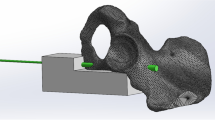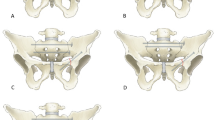Abstract
Purpose
To determine union and displacement metrics following percutaneous screw fixation (antegrade or retrograde) of superior pubic rami fractures.
Methods
This is a retrospective cohort study from a single level 1 trauma center. Skeletally mature patients with at least one superior pubic ramus fracture present as part of a lateral compression-type pelvic ring injury were included.
Results
Eighty-five (85) patients with 95 superior pubic rami fractures met the study’s inclusion criteria. LC1, LC2, and LC3 injuries occurred in 76.5%, 15.3%, and 8.2% of patients, respectively. The majority of patients underwent concurrent posterior pelvic ring fixation (94.1%). Superior ramus screw placement occurred predominantly via retrograde technique (81.1%) with cannulated screws of size 6.5 mm or larger (93.7%). Of the 95 eligible fractures, 90 (94.7%) achieved union at a mean of 14.0 weeks (7–40 weeks). Of these united fractures, 69 (76.7%) healed with no measurable displacement, while the remaining 23.3% healed with residual mean displacement of 3.9 mm (range: 0.5–9.0 mm). Multivariable analysis demonstrated a positive association between age (p = 0.04) and initial displacement (p = 0.04) on the final degree of residual displacement at union. A Kaplan–Meier survival analysis identified increased age to be significantly related to increased time to union (X2 (2) = 21.034, p < 0.001).
Conclusions
Union rates following percutaneous screw fixation of superior pubic rami fractures associated with lateral compression-type pelvic ring injuries approach 95%. Though minimal in an absolute sense, increasing age and a greater degree of initial displacement may influence the final degree of residual displacement at union.
Level of evidence
IV.



Similar content being viewed by others
Availability of data and materials
The data were available through the FOI and TGH databases.
Code availability
Not applicable.
References
Gire JD, Jiang SY, Gardner MJ, Bishop JA (2018) Percutaneous versus open treatment of posterior pelvic ring injuries: changes in practice patterns over time. J Orthop Trauma 32:457–460. https://doi.org/10.1097/BOT.0000000000001236
Whiting PS, Auston D, Avilucea FR et al (2017) Negative stress examination under anesthesia reliably predicts pelvic ring union without displacement. J Orthop Trauma 31:189–193. https://doi.org/10.1097/BOT.0000000000000766
Sagi HC, Coniglione FM, Stanford JH (2011) Examination under anesthetic for occult pelvic ring instability. J Orthop Trauma 25:529–536. https://doi.org/10.1097/BOT.0b013e31822b02ae
Avilucea FR, Archdeacon MT, Collinge CA et al (2018) Fixation strategy using sequential intraoperative examination under anesthesia for unstable lateral compression pelvic ring injuries reliably predicts union with minimal displacement. J Bone Joint Surg Am 100:1503–1508. https://doi.org/10.2106/JBJS.17.01650
Wojahn RD, Gardner MJ (2019) Fixation of anterior pelvic ring injuries. J Am Acad Orthop Surg 27:667–676. https://doi.org/10.5435/JAAOS-D-17-00839
Banaszek D, Starr AJ, Lefaivre KA (2019) Technical considerations and fluoroscopy in percutaneous fixation of the pelvis and acetabulum. J Am Acad Orthop Surg 27:899–908. https://doi.org/10.5435/JAAOS-D-18-00102
Routt ML, Simonian PT, Grujic L (1995) The retrograde medullary superior pubic ramus screw for the treatment of anterior pelvic ring disruptions: a new technique. J Orthop Trauma 9:35–44. https://doi.org/10.1097/00005131-199502000-00006
Eastman JG, Chip Routt ML (2018) Intramedullary fixation techniques for the anterior pelvic ring. J Orthop Trauma 32(Suppl 6):S4–S13. https://doi.org/10.1097/BOT.0000000000001250
Giannoudis PV, Tzioupis CC, Pape H-C, Roberts CS (2007) Percutaneous fixation of the pelvic ring: an update. J Bone Jt Surg Br 89:145–154. https://doi.org/10.1302/0301-620X.89B2.18551
Grewal IS, Starr AJ (2020) What’s new in percutaneous pelvis fracture surgery? Orthop Clin N Am 51:317–324. https://doi.org/10.1016/j.ocl.2020.02.010
Acklin YP, Zderic I, Buschbaum J et al (2016) Biomechanical comparison of plate and screw fixation in anterior pelvic ring fractures with low bone mineral density. Injury 47:1456–1460. https://doi.org/10.1016/j.injury.2016.04.013
Comadoll SM, Matuszewski PE, Liu B et al (2021) Factors associated with failure of superior pubic ramus screws. J Orthop Trauma 35:181–186. https://doi.org/10.1097/BOT.0000000000001973
Shieh AK, Hayes CB, Shelton TJ et al (2021) Low superior pubic ramus screw failure rate with combined anterior and posterior pelvic ring fixation. J Orthop Trauma 35:175–180. https://doi.org/10.1097/BOT.0000000000001942
Starr AJ, Nakatani T, Reinert CM, Cederberg K (2008) Superior pubic ramus fractures fixed with percutaneous screws: what predicts fixation failure? J Orthop Trauma 22:81–87. https://doi.org/10.1097/BOT.0b013e318162ab6e
Kalbas Y, Kumabe Y, Pape H-C (2021) Sacral nonunion following acute major fractures: How to heal the holy bone? Results from a systematic literature review. Injury 52:2021–2024. https://doi.org/10.1016/j.injury.2021.07.044
Matta JM, Dickson KF, Markovich GD (1996) Surgical treatment of pelvic nonunions and malunions. Clin Orthop Relat Res. https://doi.org/10.1097/00003086-199608000-00024
Nicodemo A, Capella M, Deregibus M, Massè A (2011) Nonunion of a sacral fracture refractory to bone grafting: internal fixation and osteogenic protein-1 (BMP-7) application. Musculoskelet Surg 95:157–161. https://doi.org/10.1007/s12306-011-0131-x
Simonian PT, Routt ML, Harrington RM, Tencer AF (1994) Internal fixation of the unstable anterior pelvic ring: a biomechanical comparison of standard plating techniques and the retrograde medullary superior pubic ramus screw. J Orthop Trauma 8:476–482
McLachlin S, Lesieur M, Stephen D et al (2018) Biomechanical analysis of anterior ring fixation of the ramus in type C pelvis fractures. Eur J Trauma Emerg Surg 44:185–190. https://doi.org/10.1007/s00068-017-0788-4
Lucas JF, Chip Routt ML, Eastman JG (2021) Biomechanical analysis of retrograde superior ramus screw fixation constructs. J Orthop Trauma 35:187–191. https://doi.org/10.1097/BOT.0000000000001951
Lefaivre KA, Blachut PA, Starr AJ et al (2014) Radiographic displacement in pelvic ring disruption: reliability of 3 previously described measurement techniques. J Orthop Trauma 28:160–166. https://doi.org/10.1097/BOT.0b013e31829efcc5
Lefaivre KA, Slobogean G, Starr AJ et al (2012) Methodology and interpretation of radiographic outcomes in surgically treated pelvic fractures: a systematic review. J Orthop Trauma 26:474–481. https://doi.org/10.1097/BOT.0b013e3182323aa2
Funding
There is no funding source.
Author information
Authors and Affiliations
Contributions
HM helped in conception of study, F, MM collected the data, MIS, HM were involved in analysis, CF, MIS drafted the work, DW, CF contributed to revisions, HM finally approved the study.
Corresponding author
Ethics declarations
Conflict of interest
The authors declare that they have no conflict of interest.
Consent for publication
All authors grant consent for publication of this manuscript.
Informed consent
Not applicable.
Ethics statement
The study was reviewed by the IRB and approved for an exemption due to the retrospective nature of the study.
Additional information
Publisher's Note
Springer Nature remains neutral with regard to jurisdictional claims in published maps and institutional affiliations.
Rights and permissions
Springer Nature or its licensor (e.g. a society or other partner) holds exclusive rights to this article under a publishing agreement with the author(s) or other rightsholder(s); author self-archiving of the accepted manuscript version of this article is solely governed by the terms of such publishing agreement and applicable law.
About this article
Cite this article
Flanagan, C.D., Fairchild, R., McCaskey, M. et al. Union and displacement characteristics following percutaneous screw fixation of superior pubic rami fractures. Eur J Orthop Surg Traumatol (2023). https://doi.org/10.1007/s00590-023-03681-0
Received:
Accepted:
Published:
DOI: https://doi.org/10.1007/s00590-023-03681-0




